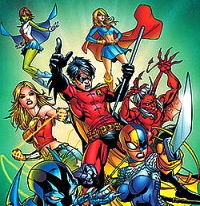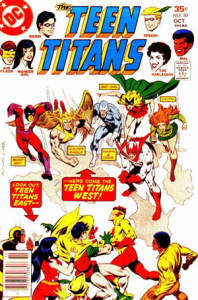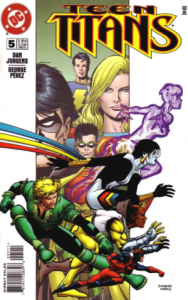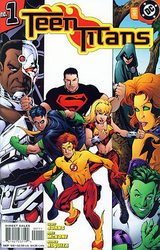Teen Titans

Go!
 Promotional cover art for Teen Titans vol. 3, #50, by Alé Garza.
Promotional cover art for Teen Titans vol. 3, #50, by Alé Garza.
The Teen Titans, also known as the New Teen Titans, New Titans, or simply theTitans, is a fictional superhero team appearing in comic books published by DC Comics, often in an eponymous monthly series. As the group’s name suggests, its membership is usually composed of teenaged superheroes.
The first incarnation of the team unofficially debuted in The Brave and the Bold#54 (1964) as a “junior Justice League” featuring Robin (Dick Grayson), Kid Flash (Wally West), and Aqualad, the sidekicks of Justice League members Batman, the Flash, and Aquaman, respectively. The group then made its first appearance under the name “Teen Titans” in The Brave and the Bold #60, joined by Wonder Girl (Donna Troy), the younger sister of Wonder Woman. Green Arrow‘s sidekick, Speedy (Roy Harper), later took Aqualad’s place in the lineup.
While only reaching modest success with its original incarnation, the series became a hit with its 1980s revival, under the stewardship of writer Marv Wolfman and artist George Pérez. In 1980, the two relaunched the team as The New Teen Titans, aging the characters to young adulthood. Original members Robin, Wonder Girl, and Kid Flash were joined by new characters Cyborg, Starfire, and Raven, as well as the former Doom Patrol member Beast Boy, now using the name Changeling. The New Teen Titans had several encounters with the original Titans of Greek mythology, particularly Hyperion. The series was retitled Tales of the Teen Titans with issue #41 (April 1984), and Pérez left in 1985 to headline the DC Comics 50th Anniversary miniseries Crisis on Infinite Earths. It was again renamed to simply The New Titans in December 1988 (issue #50), and was ultimately canceled in February 1996 after 130 issues.
The series was relaunched as Teen Titans in October 1996, with a roster of all-new members under the mentor ship of the Atom (Ray Palmer), who had been De-aged to his teenage years; the series ended in September 1998 after 24 issues. A three-issue limited series titled JLA/The Titans: The Technis Imperative(December 1998-February 1999) led to the March 1999 debut of The Titans, a series featuring select Titans from all of the group’s incarnations that ran for 50 issues until April 2003. A new regular series titled Teen Titans began in September 2003, featuring Cyborg, Starfire, Beast Boy, and Raven of the 1980s group joined by new teenaged versions of Robin (Tim Drake), Wonder Girl (Cassie Sandsmark), and Kid Flash (Bart Allen), as well as the Superman clone Superboy (Kon-El). By 2006, the team consisted of only the younger members and some new additions, and a concurrent series titled Titans debuted in April 2008 featuring some of the Titans from the original and 1980s rosters, such as Nightwing, Troia, Flash (Wally West), Tempest, Arsenal, Cyborg, Beast Boy, and Raven.
In September 2011, the Teen Titans franchise was rebooted as part of DC’s The New 52 event. The Teen Titans title was relaunched with a brand new team consisting of Red Robin (Tim Drake), Wonder Girl (Cassie Sandsmark), Kid Flash (Bart Allen), Solstice, Superboy, and new members Bunker and Skitter.
A Teen Titans animated television series ran on Cartoon Network from July 2003 to January 2006, based on the 1980’s version of the team, but diverging from it in some ways. The television series spawned two related comic book titles, Teen Titans Go! and Tiny Titans. The series returned as a series of mini-shorts on the DC Nation block on Cartoon Network.
Publication history – Original incarnation
Robin (Dick Grayson), Kid Flash (Wally West), and Aqualad — the sidekicks ofJustice League members Batman, the Flash, and Aquaman — teamed up to defeat a weather-controlling villain known as Mister Twister in The Brave and the Bold #54 (July 1964) by writer Bob Haney and artist Bruno Premiani. They subsequently appeared under the name “Teen Titans” in The Brave and the Bold#60 (July 1965), joined by Wonder Woman‘s younger sister Wonder Girl (Donna Troy) in her first appearance. After next being featured in Showcase #59 (December 1965), the Teen Titans were spun off into their own series with Teen Titans #1 (cover-dated February 1966) by Haney and artist Nick Cardy.
The series’ original premise revolved around the Teen Titans helping teenagers, answering calls from around the world. Comics historian Les Daniels noted that the title’s writer, Bob Haney, “took some ribbing for the writing style that described the Teen Titans as ‘the Cool Quartet’ or ‘the Fab Foursome’. The attempt to reach the youth culture then embracing performers like the Beatles and Bob Dylan impressed some observers as strained.” Green Arrow‘s sidekick Speedy (Roy Harper) makes guest appearances before officially joining the team in Teen Titans #19. Aqualad takes a leave of absence from the group in the same issue but makes several later guest appearances, sometimes with girlfriend Aquagirl. Neal Adams was called upon to rewrite and redraw a Teen Titans story which had been written by then-newcomers Len Wein and Marv Wolfman. The story, titled “Titans Fit the Battle of Jericho!”, would have introduced DC’s first African American superhero but was rejected by Publisher Carmine Infantino. The revised story appeared in Teen Titans #20 (March–April 1969). Wolfman and Gil Kane created an origin for Wonder Girl in Teen Titans #22 (July-Aug. 1969) which introduced the character’s new costume. Psychic Lilith Clay and Mal Duncan (who possess no superpowers) also join the group. Beast Boy of the Doom Patrol makes a guest appearance seeking membership but was rejected for being too young at the time; existing heroes Hawk and Dove, a duo of teenaged super powered brothers, appear in issue #21; and time-displaced caveman Gnarrk aids the team in two issues.
The theme of teenagers learning to take on adult roles and responsibilities was common throughout the series. The series explored then current events such as inner-city racial tension and various protests against the Vietnam War. One storyline beginning in issue #25 (February 1970) saw the Titans deal with the accidental death of a peace activist, leading them to reconsider their methods. As a result, the Teen Titans briefly abandoned their identities to work as ordinary, powerless civilians, but the change was quickly abandoned. Along the way, Aqualad was removed from the series and the character of Mr. Jupiter, who was Lilith’s mentor and employer, was introduced and financially backed the Titans for a brief period. The series was canceled with #43 (January–February 1973).
1970’s revival
 Teen Titans #50, with the majority of the Titans of that era.
Teen Titans #50, with the majority of the Titans of that era.
A few years after its cancellation, the series resumed with issue #44 (November 1976). The stories from the revival included the introduction of the African-American superheroine Bumblebee, the introduction of the “Titans West” team, consisting of a number of other teen heroes including Bat-Girl (Betty Kane) and Golden Eagle, and the introduction of Joker’s Daughter in Teen Titans #48. The revival was short-lived, and the series was canceled as of #53 (February 1978), that also told the story of how the Teen Titans were founded. In that story the heroes realized that, now in their early 20s, they had outgrown the “Teen” Titans. In the last panel, without speaking, they go their separate ways.
The title was used again in 1999 for the Teen Titans Annual #1, 1967 issue (ISBN 1-56389-486-6), a one-shot special that reprinted selected Silver Age stories in the 1960s-style 80-Page Giant format, as a companion piece to the original comic book series, had an Annual issue been published at that time.
The New Teen Titans (1980–1996)
DC Comics Presents #26 introduced a team of new Titans, anchored by founding members Robin, Wonder Girl, and Kid Flash, and soon followed by The New Teen Titans #1 (November 1980). The series, created by writer Marv Wolfman and artist George Pérez, re-introduced the Doom Patrol’s Beast Boy as Changeling and introduced the machine man Cyborg, the alien Starfire, and the dark empath Raven. Raven, an expert manipulator, forms the group to fight her demonic father Trigon the Terrible, and the team remains together thereafter as a group of young adult heroes.
The team’s adversaries included Deathstroke the Terminator, a mercenary who takes a contract to kill the Titans to fulfill a job his son had been unable to complete. This led to perhaps the most notable Titans storyline of the era (1984’s “The Judas Contract,” in Tales of the Teen Titans #42-44 and Teen Titans Annual #3) in which a psychopathic girl named Terra, with the destructive power to manipulate earth and all earth-related materials, infiltrates the Titans in order to destroy them. “The Judas Contract” won the Comics Buyer’s Guide Fan Award for “Favorite Comic Book Story” of 1984, and was later reprinted as a standalone trade paperback in 1988. This story also featured Dick Grayson (Robin) adopting the identity of Nightwing, Wally West giving up on his Kid Flash persona and quitting the Titans (which eventually led to him becoming the third Flash), and the introduction of a new member in Jericho, the other son of Deathstroke.
Other notable New Teen Titans stories included “A Day in the Lives,…” presenting a day in the team members’ personal lives; “Who is Donna Troy?” depicting Robin investigating Wonder Girl’s origins; and “We Are Gathered Here Today,…” telling the story of Wonder Girl’s wedding, a rare superhero wedding in that a fight does not break out. Tales of the New Teen Titans, a four-part limited series by Wolfman and Pérez, was published in 1982, detailing the back-stories of Cyborg, Raven, Changeling, and Starfire.
The New Teen Titans and the Uncanny X-Men
The New Teen Titans was widely thought of as DC’s answer to the increasingly popular Uncanny X-Men from Marvel Comics, as both series featured all-new members and depicted young heroes from disparate backgrounds whose internal conflicts were as integral to the series as was their combat against villains. The two teams met in the 1982 crossover one-shot entitled “Apokolips… Now”, which teamed Darkseid, Deathstroke, and Dark Phoenix against both teams. The story was written by Chris Claremont and drawn by Walt Simonson and Terry Austin.
The New Teen Titans (vol. 2)
The New Teen Titans title was relaunched with a new #1 issue in August 1984 as part of a new initiative at DC informally referred to as “hardcover/softcover”. The New Teen Titans, along with Legion of Super-Heroes and Batman and the Outsiders, were the first and only titles included in this program, where the same stories would be published twice, first in a more expensive edition with higher-quality printing and paper distributed exclusively to comic book specialty stores, then republished a year later in the original low-budget format and distributed to newsstands. The New Teen Titans title was renamed Tales of the Teen Titans (not to be confused with the earlier limited series), while a new concurrently published series named The New Teen Titans (vol. 2) launched with a new #1. After both titles ran new stories for one year, the former book began reprinting the latter’s stories for the newsstand, continuing until the “hardcover/softcover” idea was abandoned after Tales of the Teen Titans #91.
Issue #1 of New Teen Titans (vol. 2) created controversy when Dick Grayson and Starfire were depicted in bed together, although it had been established for some time that they were a couple. The initial storyline, “The Terror of Trigon,” featuring Raven’s demon father attempting to take over Earth, and Raven’s own struggle to remain good despite Trigon’s evil demonic blood inside her. Pérez left the series after issue #5. José Luis García-López followed Pérez as the title’s artist, and Eduardo Barretocontributed a lengthy run after García-López. Paul Levitz scripted and wrote several issues of the Brother Blood saga when Wolfman briefly took a break from the book. Pérez temporarily returned as co-plotter/penciller with issue #50, with the series name being amended to The New Titans, without the “Teen” prefix, as the characters were no longer teenagers.
Issue #50 told a new origin story for Wonder Girl, her link to Wonder Woman having been severed due to retcons created in the aftermath of Crisis on Infinite Earths. Pérez remained as penciller with the book through to issue #55, 57 and 60, while only providing layouts for issues #58-59, and 61, with artist Tom Grummett finishing pencils and Bob McLeod as inker. Pérez remained as inker for the cover art to issues #62-67. He would return for the series final issue with #130 (Feb. 1996) providing cover art. Wolfman and Grummett revitalized the series and introduced a number of new characters and put older characters through radical changes during the few years. Members during this time included Phantasm, Pantha, and Red Star.
Other new members of the team in the latter part of the run included Impulse, Damage, Green Lantern (Kyle Rayner), Supergirl, Rose Wilson, Minion, and Baby Wildebeest. As a result, the group that appeared in the final issue, #130 (February 1996), had little resemblance to the one that anchored DC’s line-up in the early 1980’s.
With the Teen Titans properties rivaling Marvel’s X-Men for popularity, another new title was launched in August 1986, this time to focus less on the team itself than on individual Titans, hence “Spotlight.” The series aimed to “put the spotlight on individual members of the Teen Titans, one at a time, and let each story dictate how many issues it should run,” most storylines running just a single issue, after the series launched with a two-part focus on Starfire and a four-issue highlighting of Jericho. The series ran for 21 issues, the last issue departing slightly from its aim to highlight individuals, culminating in a “Spotlight” on the 1960s Teen Titans team as a whole (April 1988), although there had previously been an issue focusing on another team, the Brotherhood of Evil.Teen Titans Spotlight On
Team Titans
The Team Titans were one of 100 groups sent back through time to prevent the birth of Lord Chaos, the son of Donna Troy and Terry Long. Their mission was to kill the pregnant Donna Troy before she could give birth. Mirage, Killowat, Redwing, Terra, Dagon, Prestor Jon, and Battalion made up the team.
Teen Titans (vol. 2, 1996–1998)
 Cover of Teen Titans (vol. 2) #5, featuring the 1996–98 team. Art by Dan Jurgens & George Pérez.
Cover of Teen Titans (vol. 2) #5, featuring the 1996–98 team. Art by Dan Jurgens & George Pérez.
A new Teen Titans series written and penciled byDan Jurgens began later that year with a new #1 (October 1996), with former New Teen Titans co-creator George Pérez as inker (Pérez would ink the first 15 issues of the series). Atom, who had become a teenager following the events of Zero Hour, leads the brand-new team, with Arsenalbecoming a mentor about halfway through the twenty four-issue run, which ended in September 1998.
In an attempt to boost sales, a contest was held in the letter pages to determine who would join the team. Robin (Tim Drake), won the vote, but editors on the Batman titles banned Robin from appearing in the Teen Titans, forcing Jurgens to use Captain Marvel Jr. instead. The inclusion of Captain Marvel Jr. failed to boost sales of the title, which was then canceled.
Titans (1999–2002)
Teen Titans (vol. 3, 2003–2011) Cover to Teen Titans vol. 3, #1 (July 2003). Art by Mike McKone.
The team was revived in a three-issue limited series, JLA/Titans: The Technis Imperative, featuring nearly every character who had been a Titan and showcased the return of Cyborg. This limited series led into Titans written by Devin Grayson, starting with Titans Secret Files #1 (March 1999).
This incarnation of the team consisted of a mix of former original Titans, including Nightwing, Troia, Arsenal, Tempest, and the Flash (Wally West), from the original team; Starfire, Cyborg, and Changeling, from the New Teen Titans; Damage from the New Titans (the 1994 series); and Argent from the Teen Titans (the 1996 series). There was one new member, Jesse Quick. This version of the team lasted until issue #50 (2002). The West Coast branch of the team, Titans L.A., appeared once, in the pages of Titans Secret Files #2.
Between the end of Teen Titans and the beginning of Titans, the next generation of young heroes: Superboy, Robin, Impulse, Wonder Girl, Secret, and Arrowette, formed their own team in Young Justice, a series similar to the original Teen Titans. Both series were concluded with the three-issue limited series Titans/Young Justice: Graduation Day, which led into new Teen Titans and Outsiders ongoing series.
Writer Geoff Johns‘ Teen Titans series began in 2003, featuring a mix of previous and new members, most of whom had been part of Young Justice. Johns wrote the book for the first forty-five issues before turning it over to Adam Beechen, who wrote the book for a four-issue run from #46 to #49 after Johns’ departure. Sean McKeever became the series’ next writer and wrote from issue #50 through #71. Following McKeever, Bryan Q. Miller wrote issues #72-74. Felicia Henderson took up the helm with issue #75.
The series’ original lineup parallels the lineup of Marv Wolfman’s New Teen Titans series: veteran members Cyborg, Starfire, and Beast Boy return, joined by younger heroes Robin, Superboy,Wonder Girl, and Kid Flash. Johns had also wanted to use the character Static, (who was then just coming off of the popular animated series Static Shock) as part of the starting roster, but was not permitted to do so due to legal issues. Raven re-joins the team in issue #12, and the new Speedy joins the team in Green Arrow #46, first appearing in the Titans book in issue #21. Starfire left the Teen Titans for the Outsiders. During the “Insiders” crossover with The Outsiders (issues #24–25), Superboy comes under Lex Luthor‘s control and attacks the team, afterwards taking a leave of absence that ends during Infinite Crisis. The new series sees the team’s relocation from the east to the west coast, its headquarters located in San Francisco instead of the traditional New York City location. The new Titans Tower also has a memorial hall with statues of the fallen Titans.


